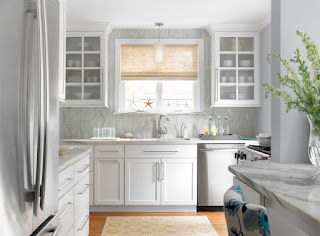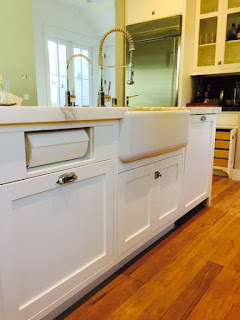Battle of the Backsplashes: Glass Mosaics vs. Natural Stone
by Sam Ferris
Read about the pros and cons — and see great examples —
of these
two popular kitchen backsplash materials
One of the many great kitchen debates involves backsplashes. Just as
they do when considering cabinets, countertops, paint colors and flooring,
homeowners care about factors such as cost, maintenance and resale value when
they’re shopping for a new design. Glass mosaics and natural stones — such as
travertine, marble, soapstone, granite and quartz — are two options that get
the lion’s share of attention, so we decided to lay the pros and cons on the
table. Use this head-to-head showdown to choose the winner for your kitchen space.
The Case for Glass
Mosaics
1. They offer a high-end look. Glass mosaics sure know how to dazzle. They’re much more polished than natural stone, which is undoubtedly why they often feel more luxurious. Certain color combinations and shapes can make an artistic statement, while iridescent and shiny finishes can make neutral tones feel as bold as primary colors.
2. They’re a hot
commodity right now. Glass mosaics are trending. Whether it’s because of how
sharp they look or because they’re a fresh alternative to traditional choices
such as natural stone and ceramic is up for debate, but there’s no denying their
selling power. That’s good news if you’re sprucing up your kitchen for resale.
If you’re planning to list your home in the near future, a glass backsplash can
certainly seal the deal.
3. They’re relatively
easy to clean. Grout joints aside, the smooth surface of glass mosaics
translates to simple cleaning. It’s a cinch to wipe down, and you don’t have to
be as selective with cleaning products as you do with natural stone. However,
you can run into higher maintenance with more intricate styles that have excess
nooks and crannies or mixed materials such as stone and metal.
The Case Against Glass Mosaics
1. They can be costly. You might have to crack open the piggy bank when purchasing a glass mosaic. In general, they cost more than natural stone backsplashes. Quality glass mosaics rarely cost less than $10 per square foot. Most cost between $20 and $30 per square foot, with high-end options topping $50 per square foot. These are no small investments, even for kitchens with less ground to cover.
2. They can quickly go
out of style. Long-term resale value is questionable when it comes to glass
mosaics. Colors and patterns that are in style now probably won’t be in five or
10 years, not to mention that glass mosaics themselves may not be either. Take
into account your long-term plans. If you’re not living in your forever home
right now, you may want to play it safe with natural stone.
3. They’re seldom unique. Some
people would label glass mosaics as cookie-cutter. Yes, some designs are one of
a kind — particularly those that are crafted by hand or manufactured with
avant-garde techniques. Most styles are mass produced, however, which
eliminates the novelty factor. They aren’t like natural stone, which is an
innately unique product. On the plus side, with so many glass mosaic styles
available, you may just stumble upon one that not many homeowners have.
The Case for Natural
Stone
1. It has universal appeal. If you’re remodeling with future resale in mind, a natural stone backsplash should be at the top of your list. Not only are travertine and marble — to name two — timeless, but they’re also well-liked, which gives them top-notch staying power. They will appeal to a large buying audience, whether you’re selling in five, 10 or 15 years.
2. No two stone
backsplashes are the same. The beauty of natural stone is that it
won’t ever look exactly like your neighbor’s. Variation is an inherent property
of stone, even within two pieces of the same color. All of the veins and swirls
will belong uniquely to your kitchen. If you’re looking for something to call
your own, go with natural stone.
3. It doesn’t cost a
fortune. Natural stone is budget-friendly. Travertine, for
example,comes in many forms (subway tile, 4 by 4, mosaic), all relatively
affordable.
The Case Against Natural Stone
1. It’s harder to clean. This isn’t to say stone is necessarily hard to clean. It just requires a little more elbow grease than a glass mosaic does. The pits and grooves make it more challenging to wipe down, especially because dirt and scum can get caught in between.
You also have to be selective with your cleaning products. Natural stone can discolor when exposed to certain chemicals. Warm water or a special stone cleaner will usually do the trick, but always check manufacturer guidelines before you bust out your cleaning supplies.
2. It isn’t water- or
stain-friendly. Stones are naturally porous. They tend to absorb stains
and water, both of which run rampant in kitchens. It’s important to seal your
stone every couple of years to protect against grease and grime. Even then,
some stains will be hard to remove. Some homeowners just don’t have the time or
patience for this added maintenance. Devoted cooks might want a backsplash
that’s better equipped against staining.
3. It can have too much
variation. Natural stone is unpredictable. There’s a good chance your
backsplash installation will look a tad different from the sample piece you saw
at your local retailer. Variation usually isn’t a problem, and most homeowners
choose natural stone for a diversified look. But sometimes you’ll notice colors
and patterns that you don’t really care for — and you have to either live with
them or start from scratch.
At Cabinet-S-Top, we welcome the opportunity to be your professional and help you create a stylish and beautiful kitchen you can enjoy everyday. Give us a call at 330.239.3630 or visit our showroom located at 1977 Medina Road, Medina, OH 44256 ~ www.cabinet-s-top.com














Comments
Post a Comment